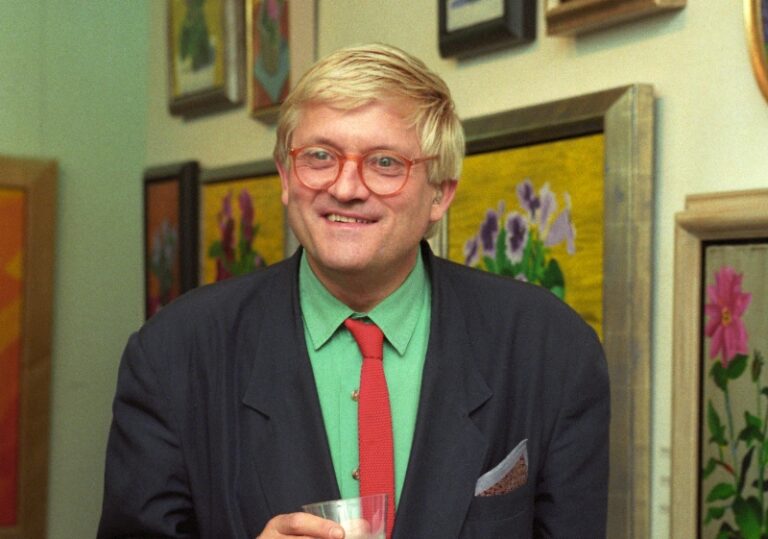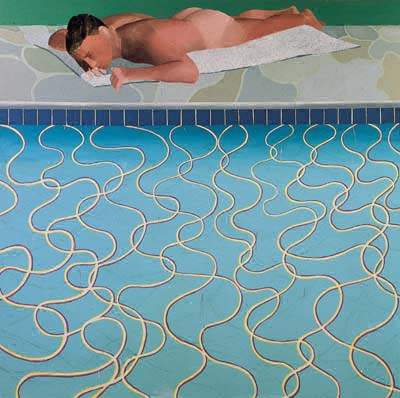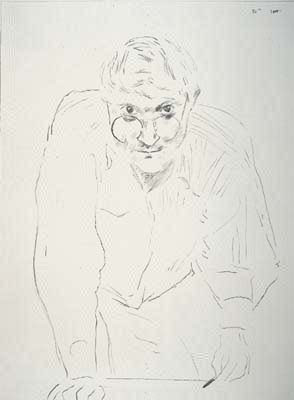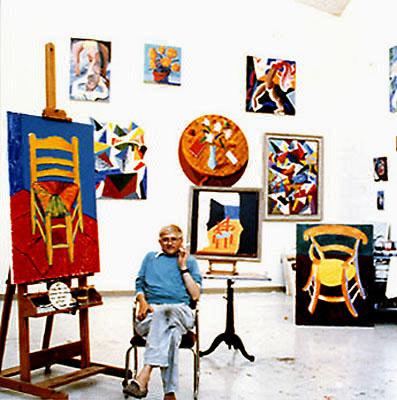The 1st
LaureatePainting
David Hockney

One of the stars of British pop art in the 1960s,Hockney arrived on the scene with a mop of dyed blond hair,a gold lamé jacket and some figurative paintings that offered a daringly different outlook on life. He became an instant popular favourite. A fascination with California led to paintings of swimming pools showing a unique approach to depicting water and the effects of light. He designed brilliant and colourful sets for opera houses around the world,developed new techniques in photocollage and made large-scale landscape paintings which demonstrated an involvement in perspective stimulated by his interest in Picasso and cubism. Hockney’s work is deeply engaged with the traditions of art,always questioning,always showing by example. He is one of the great British painters working today.
Biography
Rumours about an unusually gifted Bradford art student were heard in Yorkshire in 1957–58 but it was in 1962,at the age of 24,that David Hockney became a popular star,thanks both to his cheerfully irreverent paintings and to dyeing his hair blond and donning a golden jacket to collect the Gold Medal reluctantly awarded him by the Royal College of Art in London. All Britain seized on him,and other young artists associated with him,as a refreshing alternative to the older,more highbrow artists who were then exhibiting. The new art was jokey and full of narrative,whereas the established abstract painting had distanced much of the public. These young artists and their activities came over as well on television (notably in Ken Russell’s Pop Goes the Easel,1962,for BBC TV) as they did in the press and glossy magazines. Soon we were calling it pop art and recognising it as a British innovation. Hockney was quickly known abroad,with visits to New York,Berlin and Los Angeles,other trips in Europe and to Egypt,and then a working pattern that divided his time between California and London.
His work changed in character and range – its variety revealing the essential artist. A combination of good humour and open-eyed wonderment at the world and at what art can do remains basic. His last works in Bradford had been elegant,calligraphic abstracts. At the Royal College he had brought personal themes and topical imagery into his work. So did his fellow students,sometimes to make political or cultural comments,sometimes in an urge to celebrate life. The latter was Hockney’s way,and it came to dominate English pop art partly through his success. He had his first solo show in London in 1963,entitled ‘Paintings with People In’. Many more solo exhibitions followed in London and abroad: New York 1963,Amsterdam,Milan,Brussels 1966,and so on,with contributions also to group shows all over the globe. In 1970 he had a remarkably complete retrospective show in London.
His prints and drawings always drew as much attention as his paintings,especially his suite of etchings The Rake’s Progress,1961–63,revisiting Hogarth’s famous eighteenth-century engravings in terms of Hockney’s experiences in New York. This way of making myths out of encountered realities and borrowing productively from the arts of other ages and cultures,while also attempting a wide range of image-making methods including instant photography and colour photocopying,has continued to give Hockney a lively and exceptionally cheerful image among his contemporaries. His paintings of the sixties include many a joke,in words and image,even while signalling his homosexual passions or his admiration for,say,the Pre-Raphaelites or Egyptian monumental sculpture. They also show a rapid development into smooth and sophisticated renderings of scenes,made poetic by his fine feeling for pattern and tonal gradations. His prints of the period ranged widely in their subject matter,which included Grimm’s fairy tales,the poems of Cavafy and Alfred Jarry’s anti-academic romp of the 1890s,Ubu Roi. His drawings,especially of people – whether lovers,friends,his parents or eminent Britons and Americans – took on a refinement that proved him an outstanding portraitist in the tradition of Ingres and gave his art wide-ranging social appeal and utility. This was enhanced when,in 1975,he designed the costumes and set for Stravinsky’s The Rake’s Progress,produced at Glyndebourne Opera House,and subsequently made designs for other operas and for ballet in Britain and the USA. He made highly successful portraits also as paintings,using photographs as well as drawings as his reference material. Mr and Mrs Clark and Percy,1970–71,a portrait of the young designers Ossie Clark and Celia Birtwell and their cat,was exhibited in London together with all its related drawings and photos; it has become one of the best loved paintings in the collection of the Tate in London.
Worldwide travel enlarged his visual resources; so did admiration for great artists. He etched homages to Picasso and to Michelangelo in the seventies. He became interested both in Picasso’s transformational figuration and in the spatial and formal dislocations of cubism,exploring the latter in series of photo-collages,clusters of instant snapshots scanning his chosen subjects,mostly people and interiors. This combination of naturalistic representation and exploration of effects of space and (in shifting his viewpoints) time,led him also into a series of painted interiors and landscapes around Los Angeles; his recent work,still led by affection and curiosity but conditioned by his growing deafness and consciousness of age,finds Hockney making direct and apparently simple paintings of his friends,dogs and flowers. He has also explored photocopying and faxing to make his images available to a world eager to exhibit them. All this has involved a departure from the priorities of pop art but without shedding the responsiveness to things seen and to amusing things thought,as well as to stylistic games,which were always Hockney’s particular contributions to that movement.
Norbert Lynton
Chronology
-

Sunbather, 1966
-

A Bigger Grand Canyon, 1998
-

Self Portrait 30th Sept. 1983
-

©David Hockney

